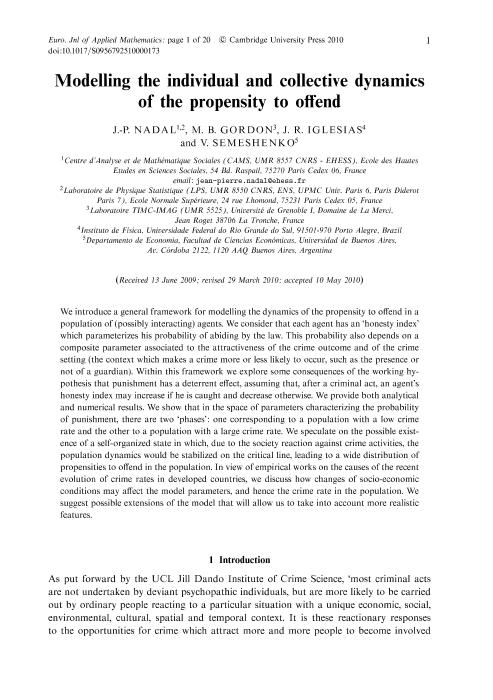Artículo
Modelling the individual and collective dynamics of the propensity to offend
Fecha de publicación:
10/2010
Editorial:
Cambridge University Press
Revista:
European Journal Of Applied Mathematics
ISSN:
0956-7925
Idioma:
Inglés
Tipo de recurso:
Artículo publicado
Clasificación temática:
Resumen
We introduce a general framework for modelling the dynamics of the propensity to offend in a population of (possibly interacting) agents. We consider that each agent has an honesty index which parameterizes his probability of abiding by the law. This probability also depends on a composite parameter associated to the attractiveness of the crime outcome and of the crime setting (the context which makes a crime more or less likely to occur, such as the presence or not of a guardian). Within this framework we explore some consequences of the working hypothesis that punishment has a deterrent effect, assuming that, after a criminal act, an agent's honesty index may increase if he is caught and decrease otherwise. We provide both analytical and numerical results. We show that in the space of parameters characterizing the probability of punishment, there are two phases: one corresponding to a population with a low crime rate and the other to a population with a large crime rate. We speculate on the possible existence of a self-organized state in which, due to the society reaction against crime activities, the population dynamics would be stabilized on the critical line, leading to a wide distribution of propensities to offend in the population. In view of empirical works on the causes of the recent evolution of crime rates in developed countries, we discuss how changes of socio-economic conditions may affect the model parameters, and hence the crime rate in the population. We suggest possible extensions of the model that will allow us to take into account more realistic features.
Archivos asociados
Licencia
Identificadores
Colecciones
Articulos(SEDE CENTRAL)
Articulos de SEDE CENTRAL
Articulos de SEDE CENTRAL
Citación
Nadal, J. P.; Gordon, M. B.; Iglesias, J. R.; Semeshenko, Viktoriya; Modelling the individual and collective dynamics of the propensity to offend; Cambridge University Press; European Journal Of Applied Mathematics; 21; 4-5; 10-2010; 421-440
Compartir
Altmétricas




